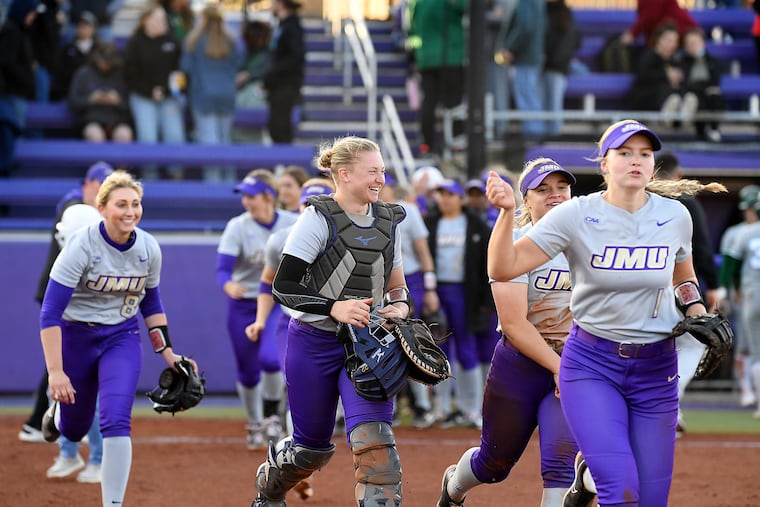Bad coaching, micromanaging, long hours: Why college athletes are so stressed
Based on interviews with hundreds of college athletes, we have several suggestions for reducing their anxiety. A lot of it boils down to taking college sports less seriously.

Earlier this year, four female college athletes died by suicide within just a two-month period. One was Lauren Bernett, of McDonald, Pa., a James Madison University softball standout and member of the National Honor Society. She was 20 years old.
Clearly, college athletics have a serious problem.
» READ MORE: Four women’s college athletes took their lives over two months as suicides continue to rise. What can be done?
The first step, of course, is to find better mechanisms of recognizing and destigmatizing college athlete stress. But we can’t just stop there; we have to start discussing the systemic roots of this anxiety. What is it about contemporary higher education and college athletics that may be contributing to athlete suicides?
How to find help
- The National Suicide Prevention Talk Line offers help in over 150 languages. Call 1-800-273-8255 or text HELLO to 741741. En Español, marca al 1-888-628-9454. If you're deaf or hard of hearing, call 1-800-799-4889.
- The Philadelphia Suicide and Crisis Center offers guidance and assessment about depression, self harm, hopelessness, anger, addiction, and relationship problems, at 215-686-4420.
- Veterans Crisis Chat is available at 1-800-273-8255 or by text at 838255.
- The Trevor Project offers crisis support to LGBTQ+ youth 25 and under. Call 1-866-488-7386, text START to 678678, or start a chat.
For the past three years, we have been examining the structural causes of college athlete stress and anxiety. To date, we have received hundreds of surveys and conducted dozens of interviews with college athletes at a large handful of Division I and Division III schools, including a few that are local. Our first wave of data shows that self-reported levels of anxiety among college athletes are extremely high. And while this is true among all students, we believe athlete-related anxiety starts before college and, given the growing importance placed on sports, is more likely to increase if not addressed.
The athletes in our survey identified academics, future plans, and sports as the top three sources of anxiety, well above a second tier of factors such as injuries, general health, and family pressure. Interestingly, we found these same three elements were identified as the leading sources of anxiety in high school, suggesting that college athletes are already stressed even before arriving on campus.
In examining the source of athletes’ anxiety, we found that athletes view the time demands of their sport as unreasonable. Over 80% of respondents reported spending more than the NCAA-mandated maximum of 20 hours a week on their sport in season and 10 hours a week off-season.
Second, bad coaching behavior is generating a lot of anxiety. In interviews with athletes, we have heard horrendous accounts of verbal abuse, pitting athletes against each other (including spying on each other), lying about scholarships and playing time, being forced to participate when injured, and overt racism. Athletes normally remain silent about this for fear of retribution. Much of this silence is rooted in organized sports norms insisting that hard work and better focus is the primary key to success. College athletes are told they are “soft” if they can’t play through physical injuries. Why wouldn’t they think similarly about mental injuries?
Third, anxiety results from the micromanaging of college athletes’ lives. Athletes are told when to rise, when and what to eat, when to study, when to practice, when to use the bathroom, and when to sleep. One interviewee likened it to being in the military. But college is supposed to be a time when people can develop new passions and begin to act like independent adults. The militarization of college sports delays that independence and often damages an athlete’s sense of individuality.
“Higher education needs to take intercollegiate sports less seriously.”
Based on our data, we have several suggestions for reducing college athlete anxiety. First, programs need to ease up on time demands. We need to move away from definitions of “rigor” based strictly on the number of hours spent on a sport. Athletes may simply need an occasional day off from practice (at their discretion) to emotionally regroup and also to discover the nonathletic wonders of college life. Higher education needs to take intercollegiate sports less seriously.
Second, schools should stop judging the value of sports and coaches primarily by winning percentages or conference championships. Emphasizing winning at all costs establishes a culture where coaching job security and occupational advancement, not to mention a school’s “brand,” start to take precedence over athlete mental health. This contributes to bad behavior by coaches and other athletics staff.
Our goal with this research is not to destroy college sports. Quite the contrary: We were all college athletes once ourselves, and we believe that intercollegiate sports can be a positive experience for players and spectators. But this is becoming less likely as college teams increasingly overload the physical and emotional bandwidth of their young adult participants. To change this, we need to change the very structure of college athletics.
Rick Eckstein, Ed Hastings, and Steve McWilliams teach, respectively, sociology, theology, and theater at Villanova University. Eckstein is also the author of “How College Athletics are Hurting Girls’ Sports: The Pay to Play Pipeline.”